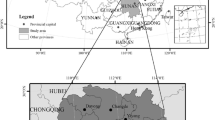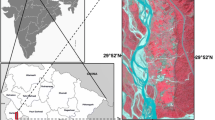Abstract
Using three-phase remote sensing images of China-Brazil Earth Resources Satellite 02B (CBERS02B) and Landsat-5 TM, tobacco field was extracted by the analysis of time series image based on the different phenological characteristics between tobacco and other crops. The spectral characteristics of tobacco and corn in luxuriant growth stage are very similar, which makes them difficult to be distinguished using a single-phase remote sensing image. Field film after tobacco seedlings transplanting can be used as significant sign to identify tobacco. Remote sensing interpretation map based on the fusion image of TM and CBERS02B’s High-Resolution (HR) camera image was used as standard reference material to evaluate the classification accuracy of Spectral Angle Mapper (SAM) and Maximum Likelihood Classifier (MLC) for time series image based on full samples test method. SAM has higher classification accuracy and stability than MLC in dealing with time series image. The accuracy and Kappa of tobacco coverage extracted by SAM are 83.4% and 0.692 respectively, which can achieve the accuracy required by tobacco coverage measurement in a large area.
Similar content being viewed by others
References
Claus B, Eckehard N, Kalman S, 1994. Spectrometer for fast measurements of in vivo reflectance, absorptance, and fluorescence in the visible and near-infrared. Remote Sensing of Environment, 48(1): 18–24. DOI: 10.1016/0034-4257(94)90110-4.
Clevers J G P W, Van Leeuwen H J C, 1996. Combined use of optical and microwave remote sensing data for crop growth monitoring. Remote Sensing of Environment, 56(1): 42–51. DOI: 10.1016/0034-4257(95)00227-8.
Conese C, Maselli F, 1992. Use of error matrices to improve area estimates with maximum likelihood classification procedures. Remote Sensing of Environment, 40(2):113–124. DOI: 10.1016/0034-4257(92)90009-9.
Congalton R G, 1991. A review of assessing the accuracy of classifications of remotely sensed data. Remote Sensing of Environmen, 37(1): 35–46. DOI: 10.1016/0034-4257(91)90048-B.
David B L, Gregory P A, 2004. Cropland distribution from temporal unmixing of modis data. Remote Sensing of Environment, 93(3): 412–422. DOI: 10.1016/j.rse.2004.08.002.
Delecolle R, Maas S J, Guerif M et al., 1992. Remote sensing and crop production models: present trends. ISPRS Journal of Photogrammetry & Remote Sensing, 47(4): 145–161. DOI: 10.1016/0924-2716(92)90030-D.
DeWit A J W, Clevers J G P W, 2004. Efficiency and accuracy of perfield classification for operational crop mapping. International Journal of Remote Sensing, 25(1): 4091–4112. DOI: 10.1080/01431160310001619580.
Doraiswamy P C, Sinclair T R, Hollinger S et al., 2005. Application of MODIS derived parameters for regional crop yield assessment. Remote Sensing of Environment, 97(2): 192–202. DOI: 10.1016/j.rse.2005.03.015.
Guerif M, Duke C L, 2000. Adjustment procedure of a crop model to the site specific characteristics of soil and crop using remote sensing data assimilation. Agriculture Ecosystems & Environment, 81(1): 57–69. DOI: 10.1016/S0167-8809(00)00168-7.
Han Lijian, Pan Yaozong, Jia Bin et al., 2007. Acquisition of paddy rice coverage based on multi-temporal IRS-P6 satellite AWiFS RS-data. Transactions of the Chinese Society of Agricultural Engineering, 23(5): 137–143. DOI: 1002-6819.0.2007-05-024. (in Chinese)
Kruse F A, Lefkoff A B, Boardman J B et al., 1993. The spectral image processing system (SIPS)-interactive visualization and analysis of imaging spectrometer data. Remote Sensing of Environment, 44(3): l45–l63. DOI: 10.1016/0034-4257(93)900-13-N.
Launay M, Guerif M, 2005. Assimilating remote sensing data into a crop model to improve predictive performance for spatial applications. Agriculture Ecosystems & Environment, 111(4):321–339. DOI: 10.1016/j.agee.2005.06.005.
Li Hongjun, Zheng Li, Lei Yuping et al., 2008. Estimation of water consumption and crop water productivity of winter wheat in North China Plain using remote sensing technology. Agricultural Water Management, 95(11): 1271–1278. DOI: 10.10-16/j.agwat.2008.05.003.
Li Xiangyang, Liu Guoshun, Yang Yongfeng et al., 2007. Relationship between hyperspectral parameters and physiological and biochemical indexes of flue-cured tobacco leaves. Agricultural Sciences in China, 6(6): 665–672. DOI: 10.1016/S16-71-2927(07)60098-4.
Liang S, 2001. Land-cover classification methods for multi-year AVHRR data. International Journal of Remote Sensing, 22(8): 1479–1493. DOI: 10.1080/01431160120833.
Liu Xulong, He Chunyang, Pan Yaozhong et al., 2006. Accuracy assessment of thematic classification based on point and cluster sample. Journal of Remote Sensing, 10(3): 366–373. DOI: 1007-4619.0.2006-03-012. (in Chinese)
Ma Yuping, Wang Shili, Zhang Li et al, 2008. Monitoring winter wheat growth in North China by combining a crop model and remote sensing data. International Journal of Applied Earth Observation and Geoinformation, 10(4): 426–437. DOI: 10.1016/j.jag.2007.09.002.
MacDonald R B, Hall F G, 1980. Global crop forecasting. Science, 208(4445): 670–679. DOI: 10.1126/science.208.4445.670
Mei Xin, Cui Weihong, Zhang Xuexia et al., 2006. Monitoring of tobacco planted acreage based on multiple remote sensing sources. In: IEEE International Geoscience and Remote Sensing Symposium Proceedings. Denver, USA: 668–670. DOI: 10.1109/IGARSS.2006.175.
Ming C H, Merrill K R, 2002. A subpixel classifier for urban land cover mapping based on a maximum-likelihood approach and expert system rules. Photogrammetric Engineering & Remote Sensing, 68(11): 1173–1180.
Moran M S, Inoue Y, Barnes E M, 1997. Opportunities and limitations for image-based remote sensing in precision crop management.Remote Sensing of Environment, 61(3): 319–346. DOI: 10.1016/S0034-4257(97)00045-X.
Narayanan S, Oliver W, Hartmut K L, 1999. Changes in blue-green and chlorophyll fluorescence emission and fluorescence ratios during senescence of tobacco plants. Remote Sensing of Environment, 69(3): 215–223. DOI: 10.1016/S00344257(99)-00029-2.
Peng Guangxiong, He Yuhua, Li Jing et al., 2007. Study on CBERS2’s CCD image cross calibration and atmospheric correction. Journal of Infrared and Millimeter Waves, 26(1): 22–27. DOI: 1001-9014.0.2007-01-004. (in Chinese)
Peng Guangxiong, Li Jing, Chen Yuhao et al., 2006. High-resolution surface relative humidity computation using MODIS image in peninsular Malaysia. Chinese Geographical Science, 16(3): 260–264. DOI: 10.1007/s11769-006-0260-6.
Ray S S, Dadhwal V K, 2001. Estimation of crop evapotranspiration of irrigation command area using remote sensing and GIS. Agricultural Water Management, 49(3): 239–249. DOI: 10.1016/S0378-3774(00)00147-5.
Stehman S V, Czaplewski R L, 1998. Design and analysis for thematic map accuracy assessment: Fundamental principles. Remote Sensing of Environment, 64(3): 331–334. DOI: 10.1016/S0034-4257(98)00010-8.
Tso B, Mather P M, 1999. Crop discrimination using multi-temporal SAR imagery. International Journal of Remote Sensing, (12): 2443–2460. DOI: 10.1080/014311699212119.
Wu Binfang, Liu Haiyan, 1997. The operational methods for rice area estimation using remote sensing. Journal of Remote Sensing, 1(1): 58–63. DOI: 1007-4619.0.1997-01-007. (in Chinese)
Xiao Xiangming, Boles S, Liu Jiyuan et al., 2005. Mapping paddy rice agriculture in southern China using multi-temporal MODIS images. Remote Sensing of Environment, 95(4): 480–492. DOI: 10.1016/j.rse.2004.12.009.
Xu Weidong, Yin Qiu, Kuang Dingbo, 2005. Comparison of different spectral match models. Journal Infrared Millimeter and Waves, 24(4): 296–231. DOI: 1001-9014.0.2005-04-012. (in Chinese)
Zhang Mingwei, Zhou Qingbo, Chen Zhongxin et al., 2008. Crop discrimination in Northern China with double cropping systems using fourier analysis of time-series MODIS data. International Journal of Applied Earth Observation and Geoinformation, 10(4): 476–485. DOI: 10.1016/j.jag.2007.11.002.
Author information
Authors and Affiliations
Corresponding author
Additional information
Foundation item: Under the auspices of China Postdoctoral Science Foundation (No. 20080430586, 20070420018), National Natural Science Foundation of China (No. 40801161, 40801172), Sino US International Cooperation in Science and Technology (No. 2007DFA20640)
Rights and permissions
About this article
Cite this article
Peng, G., Deng, L., Cui, W. et al. Remote sensing monitoring of tobacco field based on phenological characteristics and time series image—A case study of Chengjiang County, Yunnan Province, China. Chin. Geogr. Sci. 19, 186–193 (2009). https://doi.org/10.1007/s11769-009-0186-x
Received:
Accepted:
Published:
Issue Date:
DOI: https://doi.org/10.1007/s11769-009-0186-x




